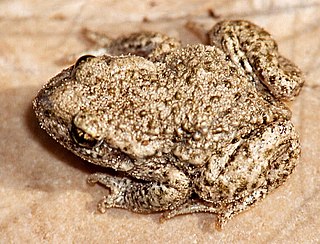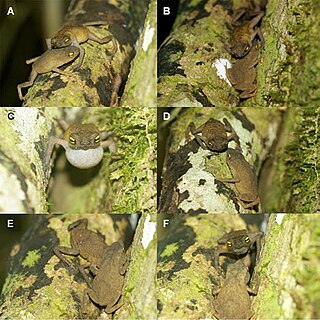
The Alytidae are a family of primitive frogs. Their common name is painted frogs or midwife toads. Most are endemic to Europe, but three species occur in northwest Africa, and a species formerly thought to be extinct is found in Israel.

Megophryidae, commonly known as goose frogs, is a large family of frogs native to the warm southeast of Asia, from the Himalayan foothills eastwards, south to Indonesia and the Greater Sunda Islands in Maritime Southeast Asia, and extending to the Philippines. Fossil remains are also known from North America. As of 2014 it encompasses 246 species of frogs divided between five genera. For lack of a better vernacular name, they are commonly called megophryids.

Suriname toads are members of the frog genus Pipa, within the family Pipidae. They are native to northern South America and extreme southern Central America (Panama). Like other pipids, these frogs are almost exclusively aquatic.

The European green toad is a species of true toad found in steppes, mountainous areas, semi-deserts, urban areas and other habitats in mainland Europe, ranging from far eastern France and Denmark to the Balkans, Western Russia and the Caucasus. As historically defined, the species ranged east through the Middle East and Central Asia to western China, Mongolia and northwestern India, and south through Italy and the Mediterranean islands to North Africa.

The Rhinophrynidae are a family of frogs containing one extant genus, the monotypic Rhinophrynus, and a number of fossil genera. The family is sometimes known as the Mexican burrowing toads or simply burrowing toads.

The red-spotted toad, formerly Bufo punctatus, is a toad in the family Bufonidae found in the southwestern United States and northwestern Mexico.

The Asian giant toad, sometimes referred to as the river toad, is a species of true toad native to Mainland Southeast Asia and the Greater Sundas. It is a medium-large toad, but it is easily confused with its larger relative, the giant river toad.

The North American green toad is a species of toad found in the southwestern United States in the states of Arizona, New Mexico, Colorado, Kansas, Oklahoma and Texas, as well as in northern Mexico in the states of Tamaulipas, San Luis Potosí, Durango, and Zacatecas. It is commonly called green toad.

The Great Plains toad is a relatively large species of true toad native to central North America.
Altiphrynoides is a genus of toads, commonly referred to as Ethiopian toads. They are restricted to highlands of south-central Ethiopia in the Arussi, Bale and Sidamo Provinces. Both species are threatened by habitat loss. They were formerly included in Nectophrynoides, but lack the unusual reproductive mode of those species. Conversely, some authorities treat Altiphrynoides as a monotypic genus for A. malcolmi, placing A. osgoodi in another monotypic genus, Spinophrynoides.

Frostius – known as Frost's toads – is a small genus of true toads consisting of only two species endemic to Brazil. The genus was proposed by David C. Cannatella in 1986 based on an analysis of a species previously classified as Atelopus. Various morphological and life-history information first suggested that it is sister taxon to Atelopus or Atelopus + Osornophryne, but later molecular evidence suggests that it is sister taxon to Oreophrynella. It was named for Darrel Frost in recognition of his work on anuran systematics.

The Guacamayo plump toad or sapo de Guacamayo is a species of toad in the family Bufonidae occurring in Colombia and Ecuador.

The Herveo plump toad is a species of toad in the family Bufonidae. It is endemic to the Cordillera Central in the Antioquia, Caldas, Quindío, and Tolima Departments, Colombia.

Osornophryne sumacoensis is a species of toad in the family Bufonidae. It is endemic to the Ecuador and only found in the forests surrounding a small crater lake on the eastern slopes of Sumaco, a volcano in the Napo Province.

Sumaco Napo-Galeras National Park is a protected area in Ecuador situated in the Napo Province, Orellana Province and Sucumbíos Province. The highest point of the park is the Sumaco volcano that peaks at 3,732 m; the lowest altitude is 600 m.

Batrachology is the branch of zoology concerned with the study of amphibians including frogs and toads, salamanders, newts, and caecilians. It is a sub-discipline of herpetology, which also includes non-avian reptiles. Batrachologists may study the evolution, ecology, ethology, or anatomy of amphibians.

Sumaco is a symmetrical, isolated stratovolcano, that is set off from the main Ecuador volcanic axis. Its rocks are very distinct from those from most Andean volcanoes because of its lack of andesitic composition, in favour of basanite and phonolitic rock. Sumaco is heavily forested and contains a small cone in its broad summit crater. An historical eruption occurred around 1895.

Atelopus barbotini, popularly known as the purple fluorescent frog or more accurately the purple harlequin toad, is a species of toad in the family Bufonidae.

















